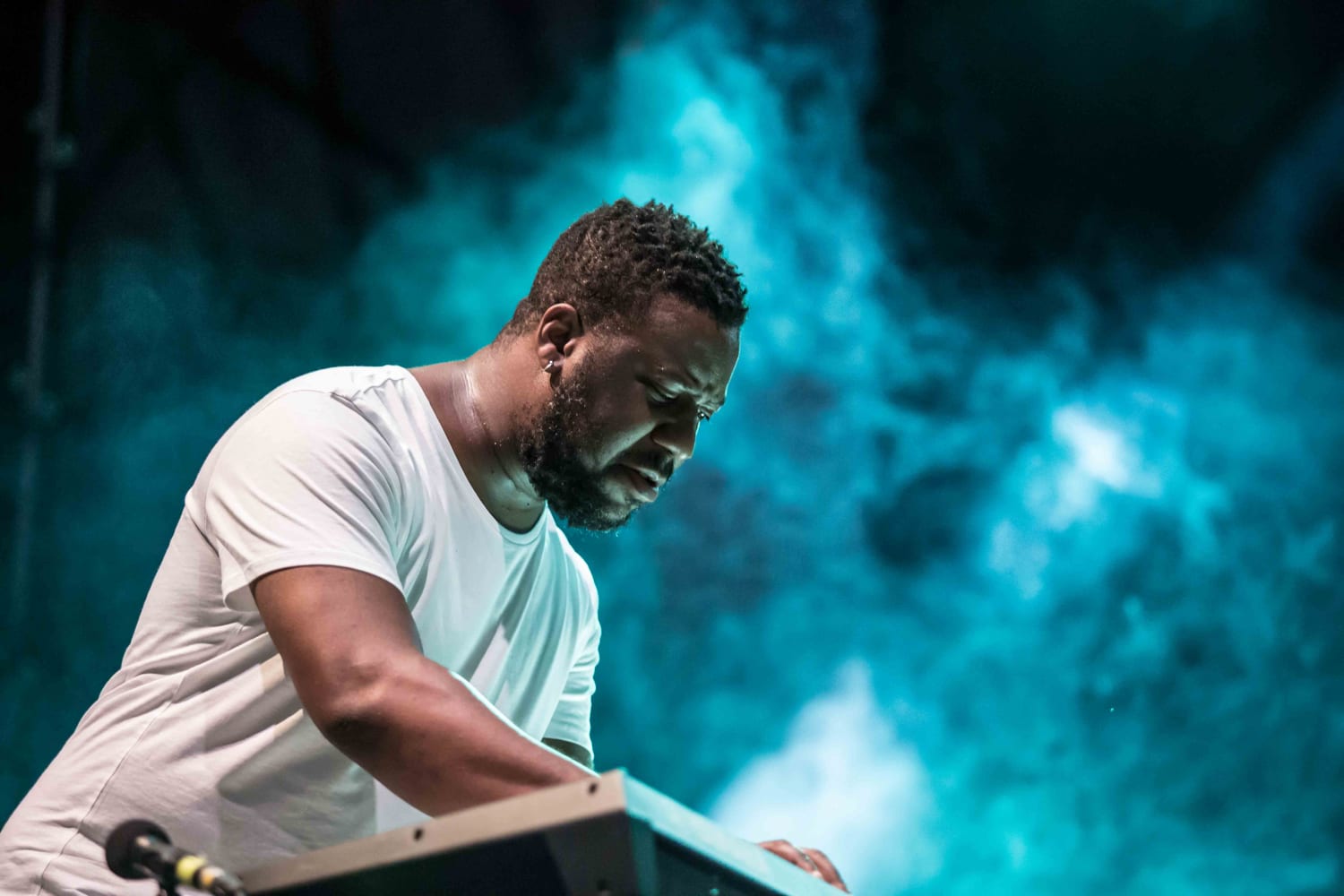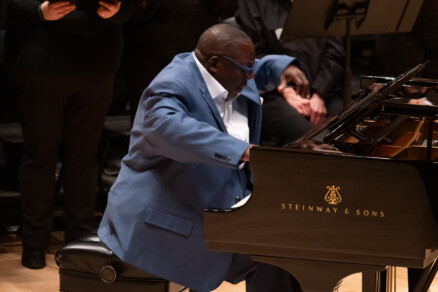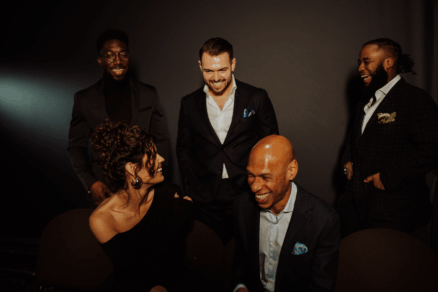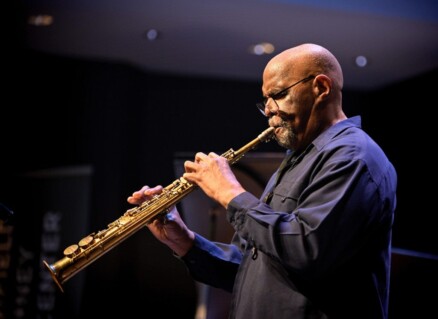Robert Glasper previews his two-week residency at the Kennedy Center

For the last 15 years, Robert Glasper has been on a singular mission to reconnect jazz to the world of popular music around it — to build a bridge from Kendrick Scott to Kendrick Lamar.
Before putting out his first recording under his own name in 2004, the pianist, bandleader and producer was working as a sideman for top jazz artists like Russell Malone and Christian McBride, but also for musicians like neo-soul singer Bilal, hip-hop producer J Dilla and MCs like Mos Def and Common. On his first recordings as a bandleader, the (primarily) acoustic trio records Mood, Canvas and In My Element, Glasper channels the sharp post-bop playing of heroes like Herbie Hancock, Mulgrew Miller and Ahmad Jamal. But even on those records, he was introducing elements from the “pop” side of his mind, weaving in hip-hop and R&B rhythmic concepts, featuring guest vocalists like Bilal, and paying tribute to Dilla with the “J Dillalude.”
That marriage was fully consecrated on the landmark Black Radio albums, recorded with his electric quartet the Experiment along with a constellation of guest rappers and singers. Glasper sees such efforts as reminding jazz of its roots as a popular dance music. “You can observe and admire in a museum, right?” Glasper told CapitalBop in a phone interview last week. “But when you’re at a dance club or a hip-hop club you’re releasing all kinds of endorphins and sweating and feeling all kinds of ways.”
Area jazz and hip-hop fans now get the rare opportunity to see the full spectrum of Glasper’s output live. He’s taking up residency over the next two weeks at the Kennedy Center, playing four nights in a row each weekend. The first half of his run is part of the center’s REACH Opening Festival, celebrating a new expansion. This week he brings his acoustic trio on Thursday and Friday, and an electric group featuring Bilal, playing music from Glasper’s Miles Davis tribute Everything’s Beautiful, , on Saturday and Sunday. Next week he will devote four nights, Sep. 26-29, to playing with longtime collaborator Yasiin Bey (formerly known as Mos Def). In his hands, will the Kennedy Center’s Studio K become the District’s hottest new club?
[Read our preview of the Kennedy Center’s REACH Opening Festival]
Glasper and I got on the phone last week to talk about how he’s prepared for this career-spanning run of shows, as well as his always-unvarnished views on the jazz ecosystem today — and what music he has coming down the pipeline. This interview has been edited for length and clarity.
CapitalBop: Is this your first full residency at the Kennedy Center?
Robert Glasper: Yeah, it’s my very first one!
CB: When you do these, whether it’s here at the Kennedy Center or at the Blue Note in New York, what’s your goal? Is it to present as much music from as many different projects as possible, or is there some kind of greater idea or narrative you want to convey?
RG: No, it’s just because I have so many projects, and what happens is, with contracts, I can really only play in a city twice a year at most. So, people normally get to see me once a year, which means I have to choose which project they get to see and all that kind of stuff. Whenever I have a chance to do more than one show in a city for a residency, I try to bring as many sides and colors [as I can] to the table, so you can see more than just one….
CB: Some of the stuff you’re doing for the residency, especially material from Everything’s Beautiful and Black Radio,, is really involved from a studio standpoint — on top of all the guests you brought to those projects. What’s it like preparing that material for a live setting? Is it easier than we might imagine?
RG: When people come to my show … if I say, “I’m doing Everything’s Beautiful,” they’re really coming to see me and whatever guest artist I have. So for this instance, I have Bilal coming, right? So really, they’re coming to see me and Bilal; it’s not a big deal if it’s not all particularly Miles Davis or things that they’ve heard from that album. They love to hear mixtures of things. So, if I’m doing Miles Davis Everything’s Beautiful, I’m going to do a lot of tracks from that album, most of the set is going to be from that album. But with that, we do other songs that aren’t even on the record; we actually extend and do more Miles Davis songs.
We’ll also do some of Bilal’s songs from his repertoire and, you know me, we might even do a song or two that Bilal has done with me on my records. As a fan, you get to see a bunch of Miles Davis stuff but you also get to hear some things that you really never get to see much … with me and Bilal together in the same room. I try to feed them as much of that as much as possible. There are certain songs that are people’s favorite songs that me and Bilal do together, but they never get to see us together. So, I try to do that.
CB: Everything’s Beautiful is one of those groups that people rarely get to see — I don’t think you’ve done it in D.C. before. So, I’m wondering, what are some of those other Miles tracks that you might perform?
RG: I’m not gonna say! [laughs] I don’t like people coming to the show expecting things. Whatever we bring them, it’s gonna be what it is.
CB: So then with the Black Radio shows, you’d say it’s more people coming to see you and Yasiin Bey (aka Mos Def) not exactly the Black Radio album.
RG: Yeah, exactly … Yasiin Bey actually did the title song for Black Radio, so we’re definitely doing that … we, as a band [the Robert Glasper Experiment], do venture off and do some things from Black Radio. As a band, there are certain things I can do without a singer that are from Black Radio as well. Normally when I have a show with Mos, we do a lot of Mos material, and we cover other people’s songs as well. We even do some Miles stuff with Mos — we have that in the repertoire.
CB: That’s something I had wanted to ask about as well, because I’ve seen videos of you and Mos doing a killer version of De La Soul’s “Stakes Is High.” I know you want to avoid playing up expectations but I wanted to know: What other more straight hip-hop tracks do you really like playing?
RG: You keep trying to do this; second time I’m gonna say it! [laughs] Because you’re going to put it in the article and if we don’t do it, people are going to be mad! I’ve had this happen before; I’ve had it happen too many times!
“Stakes Is High” is an obvious one for sure, because he loves that one. There are a lot of other ones but I don’t want to say what they are. I don’t like to put anything about songs or set in interviews because people will come for those things. I like to keep it loose and keep it to what we want to give them. If they’re there and they shout out songs we’ll try to accommodate.
CB: Black Radio got so much, and well-deserved, hype and accolades when both albums came out. But is it difficult, in some ways, to do that material because people have such a strong expectation of it? You joked at a show in Southeast D.C. a few years ago that people expect Musiq Soulchild to travel with you for shows. Is it hard to manage those expectations?
RG: [Laughs] Well, yes. Well, this is the thing: I never do a “Black Radio” show. The thing that happened is: I put out Black Radio. So then after that, I’ll just do my regular show — my trio show or my Experiment band shows — but it’s never [billed as] “Black Radio.” They just come with an expectation, but it’s not an expectation I have to fill because I don’t call it “Black Radio.” So, what I do is throw in certain songs I can play without a singer and certain songs I’ve even been singing a little bit; I can sing enough to where the crowd sings along. I did a show one time where the whole audience wanted Black Radio so bad but it was my piano trio, so I played seven Black Radio songs back-to-back and the audience sang the songs. I didn’t have to do anything. Sometimes I’ll do that: “You want to hear that? You know how to sing it, you know it? Cool, we’ll play it.” [laughs] We’ll do karaoke, live with Robert Glasper.
CB: I had also wanted to ask about your acoustic trio because — well, it’s been four years since you put out a record with that group, and it seems like you play it out less and less, and are more focused on the Experiment and other electronic groups. Is it hard coming back to it, finding inspiration for it?
RG: Actually, I do more trio gigs than people really know, but I do concentrate more on my electric stuff because I did trio for 10 years hardcore, you know what I mean? And trio only penetrates a certain audience, a certain genre in a true way. So, I have my other bands because it just penetrates a different way and we can get into different kinds of rooms when you have the electric side. It’s not hard for me to go back to trio; that’s my first love! When I get there, it’s pretty natural and I fall back in love with it. It’s hard to fit a grand piano in every place because I want to play spots that are not jazz clubs.
But a lot of the times when you play trio, the jazz musician gets stuck in the jazz club vibe, and that’s kind of the niche, and that’s kind of where they stay, for the most part: jazz clubs and theaters. They don’t play any super-cool, dope places where other hip-hop acts perform and other R&B acts perform and a lot of times, I can’t bring a piano in those rooms. A lot of times, quite frankly, pianos really don’t sound good in those rooms. The other style of music resonates in the room better and it fits the vibe better, even for the type of people that clubs attracts. You feel me?
CB: Yeah. What is that “jazz club vibe?” What is it from your perspective?
RG: The jazz club vibe is pretty much the same everywhere you go. Well, first of all, it’s small. Most jazz clubs can’t hold me in the real way to where I can get all my people in there. If I do a jazz club, I need to be there for a week to get the right amount of people in there. You’re also squished in there; there’s mostly dead jazz musicians on the wall, everywhere you look; it gives you a “museum” vibe. Nothing in there is hip, nothing in there says — there’s rarely anything in a jazz club that says it’s 2019.
‘The jazz club vibe is pretty much the same everywhere you go … There’s mostly dead jazz musicians on the wall, everywhere you look. It gives you a “museum” vibe.’
CB: And it strikes me that one of the main focal points of your career for the last decade or so has been breaking that down.
RG: Yeah!
CB: Does that stagnate the music? I’m not trying to cast aspersions or put words in your mouth, but what I hear you saying is that, “If we stay in the clubs, the music isn’t going to go anywhere.”
RG: It’s not — it’s literally not! People don’t go to jazz clubs; only hardcore jazz fans go to the jazz clubs. The jazz club is the thing that is becoming extinct. Most cities don’t even have a real jazz club that can fly in famous musicians to play; they have some local bar, you know what I mean? Most cities have regular clubs: dance clubs, hip-hop clubs, R&B clubs — they have those kinds of clubs with banging sound systems where, when you play electric music, it sounds great and people can dance and bob their heads. I like making music people can dance and bob their heads to, and people can stand up and dance. At jazz clubs, you go in there, the sound system’s not banging — at all — and people don’t stand up and dance. It’s tables and chairs everywhere. When you look at the history of jazz, when it was first popping, it was for dancing! Then they made it an “art thing,” a thing you observe versus something [where] you’re involved in it. They moved it from Harlem down to the city and put in tables and chairs.
CB: Why is it important for your vision for jazz for people to be more physically involved?
RG: It’s enjoyment; you feel like you’re really enjoying yourself. I like clubs where you’re playing and people are like “Woooooo! Yeah!” — making noise because they’re enjoying the music: clapping, dancing, having a good time. That’s what a good time looks like, know what I mean?
When you go to a jazz club, you’re observing and you’re admiring what you’re watching. You can be in awe — “Wow, they’re really good” — but that’s admiration and that doesn’t equal a good time. You can observe and admire in a museum, right? But when you’re at a dance club or a hip-hop club you’re releasing all kinds of endorphins and sweating and feeling all kinds of ways. It’s a whole different thing.
CB: Now that it’s several years after you’ve done that work of building those bridges out to the hip-hop and R&B and more pop-music worlds from jazz, do you see any talents coming up from the pop world, the R&B world who want to do more jazz things, or could come into the jazz scene?
RG: I think it’s more the other way around. I think it’s the jazz musicians opening up their minds and being able to play other styles of music and come in to the other way, you feel me? The reality is jazz makes no money, let’s just start there. [laughs] If an artist is singing R&B, nine times out of 10 they’re not trying to come into the jazz world, because it’s a lower tier of everything except musically. If they do it it’s for the music.
For the most part, jazz is only like one percent of the music wheel. It’s one of the least popular because people don’t keep it relevant. It’s mostly old-school and it’s mostly the jazz world shooting itself in the foot. The jazz publications, the jazz clubs tend to market people who are not even here anymore, more than they do young people in a real way. They push those older people or those people who are dead and gone; so, when you do that, you cut yourself out of being relevant, being in the moment.
I asked somebody the other day, “Name me a jazz song that uses the word ‘cell phone.’ Name me a jazz song that uses the word ‘text.’ Name me a popular jazz song that uses the words ‘text’ or ‘cell phone’ or ‘computer’ or ‘Uber’ or ‘Lyft’ or anything that’s around today that’s popular.” Every other genre of music that’s popular references things of today — and those songs are actually popular.
CB: I was also thinking cats like Kendrick Lamar or Flying Lotus since they seemed to build that bridge to jazz from other places. I didn’t know if you saw others following in their mold.
RG: Oh! But that’s what I’m saying, that’s jazz musicians coming over to this; jazz musicians coming over to Kendrick. So, for example, I’m on [Kendrick Lamar’s album] To Pimp a Butterfly, so that’s the jazz musician coming to a Kendrick record. But Kendrick is a jazz lover for real and Terrace Martin, friend of mine, is a jazz saxophonist and hip-hop producer and he brought that, curated that; brought me and Kamasi [Washington] and Ambrose [Akinmusire] and a few other cats to the table. So that was dope and that was on a big-scale and I think … it gave jazz a little bit of light.
But it’s funny because if you try to do a thing like that in the jazz world, they frown upon it, mostly. For some reason the jazz world has this thing where you can’t mix things because “then it’s not jazz.” But the reality is, you can! That’s how jazz has stayed around this long, by influence. … If jazz is not a mixture of things, what is it? Jazz didn’t come here by itself; it came here by being mixed with blues, classical music and even gospel. There are so many things that go into what jazz is, and to keep it around … you have to keep injecting it with influences. That’s what it is, that’s what you got to do.
CB: I hope this next question doesn’t violate your rule about expectations. The shows you’re doing at the Kennedy Center are just a snapshot of all the music you’ve been making recently. Last year you put our albums with R+R=Now and August Greene [Glasper, Karriem Riggins and Common], but it’s also been three years since your last Experiment record and four years since your last trio record. Do you have anything cooking in the studio?
RG: I do, I do. Oh, but wait a minute, when is this coming out? Ahhhhhh, I can’t say anything. [laughs] I can’t say anything, but something’s coming soon; that’s all I can say.
Bilal, DC, DC jazz, hip-hop, jazz, Kennedy Center, Mos Def, Robert Glasper, Washington, Yasiin Bey


